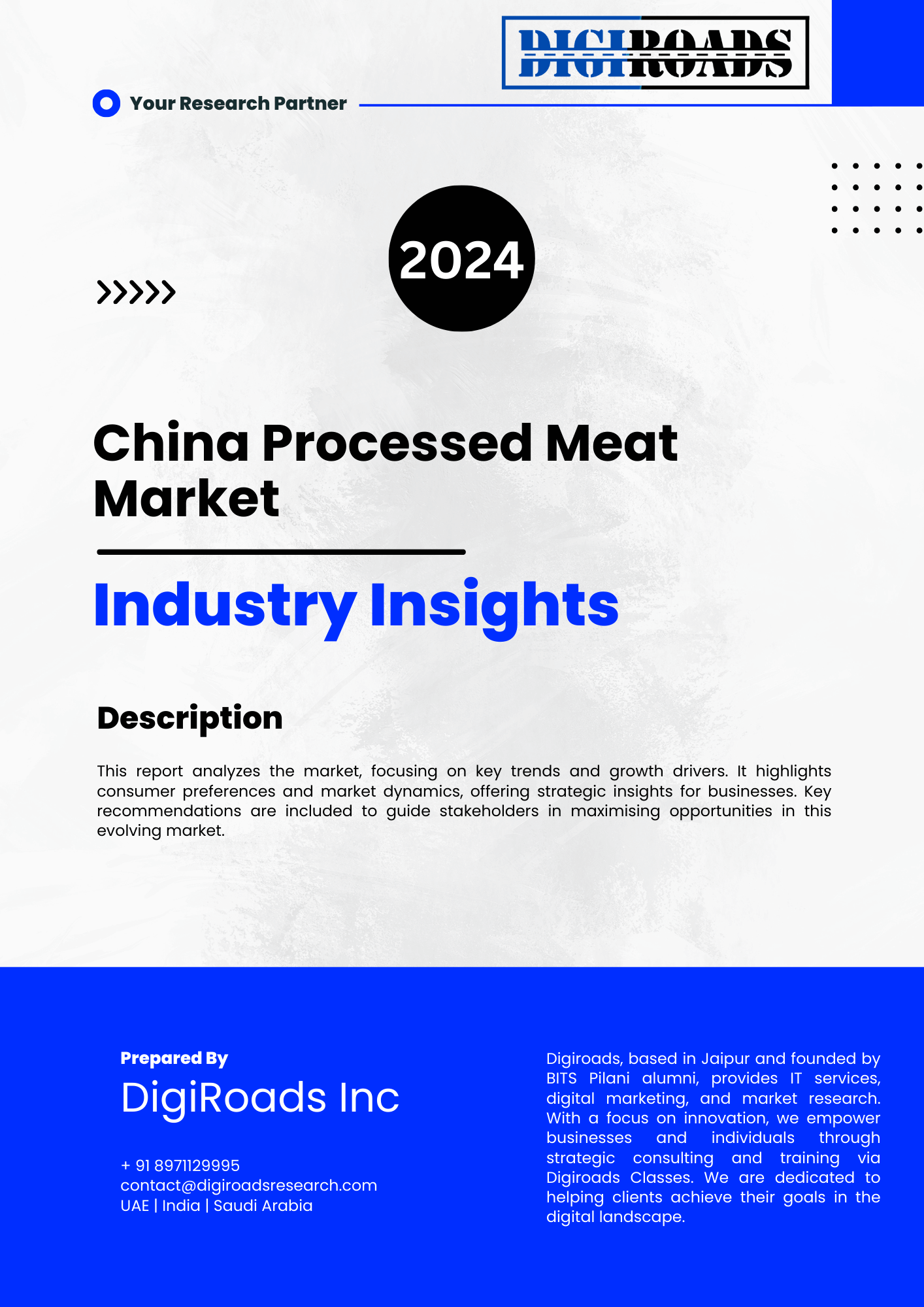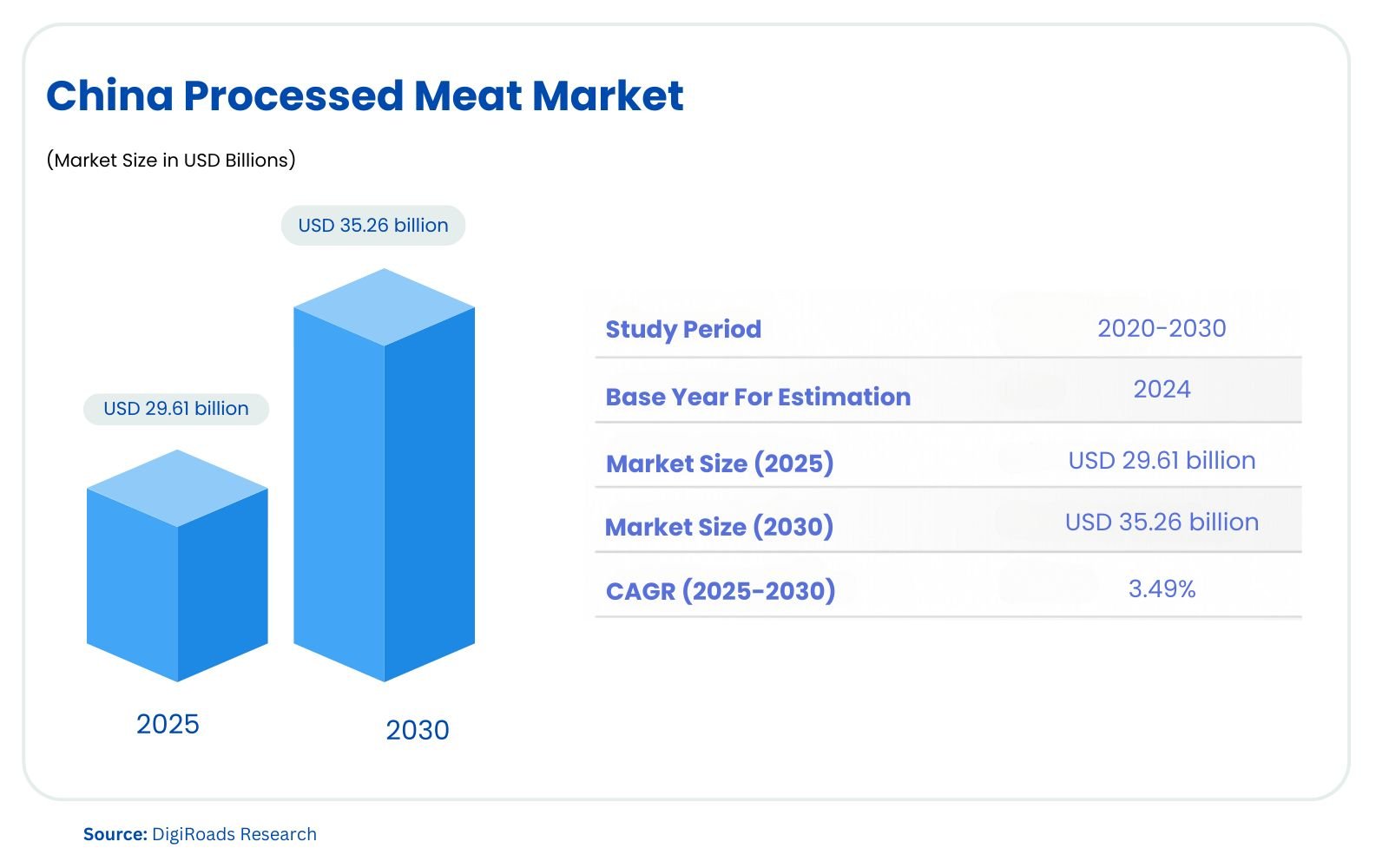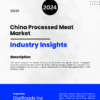No products in the cart.
China Processed Meat Market
- Brand: DigiRoads
China Food and Beverage Market Report on Processed Meat: This 100+ pages report provides detailed insights into market trends, growth factors, and competitive landscape. Available in PDF and Excel formats for comprehensive analysis and easy data access.
Category: Food and Beverage
Brand: DigiRoads
China Processed Meat Market | Market Size, Industry Analysis, Growth Opportunities, & Forecast (2025-2030)
China Processed Meat Market Overview
The China Processed Meat Market is poised for consistent growth, with a market size estimated at USD 29.61 billion in 2025, and projected to expand to USD 35.26 billion by 2030, registering a CAGR of 3.49% during the forecast period 2025-2030. The China processed meat market is expected to witness steady growth from 2025 to 2030, driven by evolving consumer preferences and increased demand for convenient, ready-to-eat products. As modern lifestyles continue to influence food consumption, there is a growing inclination toward processed meat options such as bacon, ham, and sausages. The rise in disposable income, coupled with innovations in processing technologies, is propelling the market forward. Additionally, health-conscious consumers are increasingly seeking high-quality, premium meat products that offer convenience without compromising on taste.
Key factors influencing the market include the expansion of online retailing platforms, which provide consumers with convenient access to a variety of processed meat products at competitive prices. Major players in the market, such as Tyson Foods, WH Group, and Hormel Foods, are strengthening their positions through strategic partnerships and acquisitions. Moreover, the Chinese government’s support for modern trade channels and food safety regulations continues to drive market expansion. The market remains highly competitive, with both local and global players striving to capture a significant share in the growing sector.
Market Report Coverage:
The “China Processed Meat Market Report—Future (2025-2030)” by Digiroads Research & Consulting covers an in-depth analysis of the following segments in the market.
| Meat Type | Poultry, Beef, Pork, Mutton, Other Meat Types |
| Product Type | Chilled, Frozen, Canned/Preserved |
| Distribution Channel | Supermarkets/Hypermarkets, Convenience Stores, Online Retailing, Other Channels |
Study Assumptions and Definitions
This report on the China Processed Meat Market (2025-2030) is based on a thorough analysis of historical data, market trends, and future projections. The market size and growth projections are based on estimates from reliable sources, including industry reports, financial data, and consumer behavior insights. The forecast period for this report spans from 2025 to 2030, focusing on trends, technologies, and factors expected to shape the processed meat industry during this period. The study assumes steady economic conditions, along with increasing demand for convenience food products driven by urbanization, evolving dietary habits, and the expansion of online retailing.
Processed meat is defined as any meat that has been altered from its original form through curing, salting, smoking, fermentation, or other preservation methods. These products include items such as bacon, sausages, ham, and other ready-to-eat or ready-to-cook meat products. The study includes market segments based on meat type (poultry, beef, pork, mutton, and others), product type (chilled, frozen, canned/preserved), and distribution channel (supermarkets, hypermarkets, convenience stores, online retailing, and others).
Key assumptions in this report include the continued growth of the processed meat market driven by consumer preferences for convenience and the rising influence of modern trade channels and e-commerce platforms.
Market Scope
This report provides a comprehensive analysis of the China processed meat market, covering key trends, drivers, and challenges that will influence the industry from 2025 to 2030. The market scope includes an in-depth examination of various market segments, including meat type (poultry, beef, pork, mutton, and others), product type (chilled, frozen, and canned/preserved), and distribution channels (supermarkets, hypermarkets, convenience stores, and online retailing). The study also explores the competitive landscape, highlighting major players such as Tyson Foods, WH Group, and Hormel Foods, and their strategies to expand their market presence.
The scope also includes a focus on consumer behavior, technological advancements in meat processing, and the role of e-commerce platforms in shaping purchasing patterns. Additionally, the report assesses market dynamics, including factors such as health-consciousness among consumers, the impact of urbanization, and the growing demand for premium and convenient meat products. This analysis provides actionable insights for businesses and stakeholders looking to capitalize on growth opportunities in the Chinese market.
MARKET OUTLOOK
Executive Summary
The China processed meat market is projected to experience steady growth from 2025 to 2030, with an expected market size of USD 35.26 billion by 2030. The market’s expansion is driven by evolving consumer preferences, increasing demand for convenience foods, and innovations in meat processing technologies. As consumers continue to prioritize convenience and quality, the demand for ready-to-eat and ready-to-cook processed meat products such as bacon, sausages, and ham is expected to rise significantly. Additionally, the growing middle class and changing dietary habits will further contribute to the market’s growth.
Key factors driving the market include the increasing popularity of online retailing platforms, which provide consumers with easy access to a wide variety of processed meat products at competitive prices. The rise of e-commerce in China has further fueled consumer demand, particularly during the COVID-19 pandemic, as people turned to online shopping for groceries, including frozen and chilled meat items. The government’s support for modern trade channels and food safety regulations is also boosting the processed meat market.
The market is highly competitive, with global and regional players such as Tyson Foods, WH Group, Foster Farms, Hormel Foods, and NH Foods leading the market. These companies are focusing on strategic partnerships, acquisitions, and product innovation to strengthen their market presence. Additionally, there is a growing focus on offering premium, high-quality meat products that cater to health-conscious consumers.
This report covers various segments of the market, including meat type (poultry, beef, pork, mutton), product type (chilled, frozen, canned), and distribution channels (supermarkets, convenience stores, online retailing). The report also explores market trends, challenges, and opportunities, providing valuable insights for stakeholders looking to capitalize on the growing demand for processed meat in China.
COMPETITIVE LANDSCAPE
The China Processed Meat Market is moderately fragmented, with regional and multinational players competing fiercely for market share.
Key Market Players
- Tyson Foods, Inc.
- WH Group Limited
- Foster Farms
- Hormel Foods Corporation
- NH Foods Ltd.
- CHERKIZOVO GROUP
- China Yurun Food Group Ltd.
- China Xiangtai Food Co., Ltd.
- Shandong Delisi Group Co., Ltd.
- Zhucheng Waimao Co., Ltd.
Market Share Analysis
The China processed meat market is highly competitive, with both global and regional players striving to capture significant market share. As of 2025-2030, the market is primarily dominated by key players such as Tyson Foods, WH Group, Foster Farms, Hormel Foods, and NH Foods, who have established strong brand recognition and extensive distribution networks across the country.
WH Group, being one of the largest producers of pork products globally, holds a significant share of the market, driven by its dominance in the pork processing segment. Tyson Foods and Hormel Foods also enjoy substantial market shares due to their well-established presence in the meat processing industry, with a wide variety of products catering to different consumer preferences.
The rise of online retailing platforms is shifting market dynamics, allowing new and regional players to gain market share by offering competitive prices and exclusive promotions. While traditional distribution channels like supermarkets and hypermarkets continue to be essential, online retailing is quickly emerging as one of the fastest-growing distribution channels, further impacting the market share of key players.
Smaller regional players, such as Shandong Delisi Group and China Xiangtai Food, are gaining traction by capitalizing on local consumer preferences and offering affordable processed meat products. However, global players continue to maintain dominance through continuous innovation, expanding product portfolios, and forging strategic partnerships.
MARKET DYNAMICS
Market Drivers and Key Innovations
The China processed meat market is experiencing robust growth, driven by several key factors that are shaping consumer behavior and industry dynamics.
Market Drivers:
- Convenience and Lifestyle Changes: As urbanization and modern lifestyles continue to influence food consumption patterns, consumers are increasingly opting for convenient, ready-to-eat, and ready-to-cook processed meat products. Products like bacon, sausages, and packaged ham are in high demand due to their quick preparation time and portability.
- Health-Conscious Consumer Preferences: There is a growing focus on premium, high-quality processed meats, with consumers seeking healthier options without compromising on taste. Innovations in meat processing, such as the introduction of leaner cuts and preservative-free options, are helping meet this demand.
- Growth of Online Retailing: The rise of e-commerce platforms in China has significantly impacted the processed meat market. Consumers are now purchasing meat products online for their convenience, competitive pricing, and the ability to access a wider variety of products.
- Increased Disposable Income: With a growing middle class and higher disposable incomes, Chinese consumers are willing to spend more on premium and international meat brands, contributing to market growth.
Key Innovations:
- Advancements in Meat Processing Technologies: Companies are investing in innovative processing techniques such as vacuum-sealing, freezing, and natural preservatives to enhance product shelf life while maintaining flavor and quality.
- Product Diversification: To cater to the increasing demand for healthier and more varied meat options, companies are introducing products like low-sodium, organic, and plant-infused meats.
These drivers and innovations are collectively shaping a dynamic and evolving processed meat market in China.
Market Challenges
- Rising Pork Prices: The outbreak of African swine fever has led to significant price increases in pork, which is the most consumed meat in China. This has impacted the affordability of processed pork products, potentially reducing consumer demand.
- Food Safety Concerns: Despite efforts to improve food safety regulations, concerns about the safety and quality of processed meats remain a significant challenge for the industry, especially in terms of preservatives and additives used in meat processing.
- Intense Competition: The market is highly competitive, with both global and regional players vying for market share. This intense competition can lead to pricing pressures, making it difficult for companies to maintain profitability.
- Changing Consumer Preferences: As health consciousness rises, consumers are shifting towards plant-based alternatives and seeking lower-fat, lower-sodium meat products. This shift may reduce demand for traditional processed meat products.
- Supply Chain Disruptions: Fluctuations in raw meat supply due to disease outbreaks, trade restrictions, or logistical issues can disrupt production and lead to higher costs for manufacturers.
- Government Regulations: Stringent regulations on meat processing, quality control, and labeling may increase operational costs for companies, especially small and medium-sized enterprises, hindering market expansion.
- Environmental Impact: Growing concerns about the environmental footprint of meat production, such as greenhouse gas emissions and water consumption, could shift consumer preferences toward more sustainable food options.
Market Opportunities
- Growing E-Commerce Platforms: The rise of online retailing offers a significant opportunity for processed meat companies to expand their consumer base by providing easy access to a variety of products, often with better pricing and convenience.
- Health-Conscious Products: With the increasing demand for healthier food options, there is an opportunity to develop processed meat products with reduced sodium, fewer preservatives, and leaner cuts. Organic and plant-based alternatives also present a growing market segment.
- Premium Product Demand: As the middle class continues to grow and disposable incomes rise, there is a strong opportunity to offer premium processed meat products such as gourmet bacon, artisanal sausages, and high-quality hams, catering to the more affluent consumer segment.
- Innovation in Meat Processing: Advancements in meat processing technologies, such as the use of natural preservatives, vacuum-sealing, and clean-label products, offer opportunities for differentiation and product innovation, enhancing product shelf life while maintaining quality and taste.
- Expansion in Tier 2 and Tier 3 Cities: With urbanization extending beyond major metropolitan areas, processed meat companies can target untapped markets in smaller cities, where rising disposable incomes and changing dietary habits are driving demand for processed foods.
- Strategic Partnerships and Mergers: Collaborations between global and local players can enhance distribution networks, improve market penetration, and introduce innovative products that cater to local tastes and preferences.
- Sustainability and Eco-Friendly Products: As consumers become more environmentally conscious, there is an opportunity to introduce eco-friendly and sustainable processed meat products, such as those with reduced carbon footprints or those produced with ethical sourcing practices.
RECENT STRATEGIES & DEVELOPMENTS IN THE MARKET
Acquisitions and Expansions:
- In 2021, Smithfield Foods Inc. acquired Mecom Group, a meat processing company, to expand its production capabilities, especially in the production of ham, sausages, and bacon. The acquisition added two large plants with a production capacity of 4,000 tonnes per month, strengthening Smithfield’s position in China’s processed meat market.
Product Innovation and Diversification:
- Hormel Foods acquired Kraft Heinz’s snack brand, Planters, in 2021, to diversify its portfolio beyond deli meats and chili into the snacking category. This move aims to tap into the growing demand for meat-based snacks and processed meat products in China.
Strategic Partnerships:
- Tyson Foods has been forming strategic partnerships with local Chinese firms to enhance its market reach and distribution capabilities. These collaborations help Tyson expand its processed meat offerings, particularly in chilled and frozen pork products.
Expansion of Online Retailing Channels:
- Companies like WH Group and Hormel Foods have been ramping up their online presence by leveraging e-commerce platforms. With the growing demand for convenience, these companies are investing heavily in digital platforms to offer discounts, promotions, and home delivery services, particularly targeting urban consumers.
Sustainability Initiatives:
- Several major players are adopting sustainable practices in their meat production processes. For instance, NH Foods Ltd. has committed to reducing its carbon footprint by improving meat production efficiencies and adopting more sustainable packaging methods.
Localized Product Offerings:
- In response to local consumer preferences, companies like Foster Farms and China Xiangtai Food Co., Ltd. have been launching region-specific products, such as premium pork and beef items, which are tailored to suit the local taste and dietary habits.
Increased Focus on Health-Conscious Products:
- As Chinese consumers become more health-conscious, processed meat brands are focusing on producing products with reduced preservatives, lower sodium levels, and organic ingredients. Tyson Foods has recently introduced a line of processed meats with clean labels, targeting the health-conscious consumer segment.
KEY BENEFITS FOR STAKEHOLDERS
Market Growth and Profitability:
- Stakeholders can capitalize on the growing demand for processed meat, driven by consumer preference for convenience and quality. With a market size expected to reach USD 35.26 billion by 2030, there is significant opportunity for profitability, especially with the rise of premium meat products.
E-Commerce Expansion:
- The expansion of online retailing presents a lucrative opportunity for stakeholders, including producers, distributors, and retailers, to increase market reach and sales. E-commerce platforms offer access to a broader consumer base, particularly in smaller cities and remote areas where traditional retail channels may be limited.
Health-Conscious Product Development:
- Stakeholders in the market can tap into the growing demand for healthier processed meat products, such as low-fat, organic, and preservative-free options. This trend offers a chance to develop innovative products that cater to the health-conscious consumer segment, increasing market share.
Diversification and Innovation:
- With consumer preferences evolving towards new flavors and meat types, stakeholders can innovate by offering diversified products, such as plant-based or alternative protein-based processed meats. This diversification helps companies differentiate themselves from competitors and appeal to a broader consumer base.
Strategic Partnerships:
- Forming partnerships with local and international players enables stakeholders to expand distribution channels, improve supply chain efficiency, and increase market penetration. This is particularly beneficial for global companies looking to enter or expand within the Chinese market.
Sustainability and Ethical Practices:
- Implementing sustainable practices and promoting eco-friendly packaging options provides stakeholders with a competitive advantage in a market that increasingly values environmental responsibility. This can lead to better brand loyalty and consumer trust.
Access to Tier 2 and Tier 3 Markets:
- As urbanization extends into smaller cities, stakeholders have the opportunity to target these emerging markets where processed meat consumption is rising. These markets present untapped potential for growth, making them crucial for future expansion strategies.
At DigiRoads Research, we emphasize reliability by employing robust market estimation and data validation methodologies. Our insights are further enhanced by our proprietary data forecasting model, which projects market growth trends up to 2030. This forward-thinking approach ensures our analysis not only captures the current market landscape but also anticipates future developments, equipping stakeholders with actionable foresight.
We go a step further by offering an exhaustive set of regional and country-level data points, supplemented by over 60 detailed charts at no additional cost. This commitment to transparency and accessibility allows stakeholders to gain a deep understanding of the industry’s structural and operational dynamics. By providing exclusive and hard-to-access data, DigiRoads Research empowers businesses to make informed strategic decisions with confidence.
In essence, our methodology and data delivery foster a collaborative and data-driven decision-making environment, enabling businesses to navigate industry challenges and capitalize on opportunities effectively.
Contact Us For More Inquiry.
Table of Contents
INTRODUCTION
- Market Overview
- Years Considered for Study
- Market Segmentation
- Study Assumptions and Definitions
- Market Scope
RESEARCH METHODOLOGY
MARKET OUTLOOK
- Executive Summary
- Market Snapshot
- Market Segments
- Meat Type:
- Poultry, Beef, Pork, Mutton, Other Meat Types
- Product Type:
- Chilled, Frozen, Canned/Preserved
- Distribution Channel:
- Supermarkets/Hypermarkets, Convenience Stores, Online Retailing, Other Channels
- Meat Type:
COMPETITIVE LANDSCAPE
- Recent Strategies (Key Strategic Moves)
- Market Share Analysis
- Company Profiles
- Tyson Foods, Inc.
- WH Group Limited
- Foster Farms
- Hormel Foods Corporation
- NH Foods Ltd.
- CHERKIZOVO GROUP
- China Yurun Food Group Ltd.
- China Xiangtai Food Co., Ltd.
- Shandong Delisi Group Co., Ltd.
- Zhucheng Waimao Co., Ltd.
MARKET DYNAMICS
- Market Drivers
- Market Challenges
- Market Opportunities
- Porter’s Five Forces’ Analysis
- Bargaining Power of Suppliers
- Bargaining Power of Buyers
- Threat of New Entrant
- Threat of Substitutes
- Competitive Rivalry
GLOSSARY OF PROMINENT SECONDARY SOURCES
DISCLAIMER
ABOUT US



